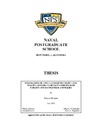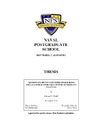Highly absorbing metal nanolaminates for bi-material THz sensors
| dc.contributor.advisor | Karunasiri, Gamani | |
| dc.contributor.advisor | Grbovic, Dragoslav | |
| dc.contributor.advisor | Jenn, David | |
| dc.contributor.author | Apostolos, Karamitros | |
| dc.date.accessioned | 2012-03-14T17:45:50Z | |
| dc.date.available | 2012-03-14T17:45:50Z | |
| dc.date.issued | 2011-09 | |
| dc.identifier.uri | https://hdl.handle.net/10945/5570 | |
| dc.description.abstract | The terahertz (THz) region of the electromagnetic spectrum covers frequencies ranging from approximately 100 GHz to 10 THz. This region of the spectrum has not been fully utilized due to the lack of compact and efficient sources as well as detectors. The aim of the present research is to explore the use of thin metal films as high THz absorbing materials and determine their absorbing characteristics in the THz range both analytically as well as experimentally. These films are to be used in bi-material-based suspended structures which sense minute changes in temperature due to THz absorption via difference in thermal expansion coefficients in materials used in the structures. Nickel thin films with thicknesses ranging from 3 to 50 nm were deposited on silicon substrates using e-beam evaporation and were characterized using Fourier transform infrared (FTIR) spectroscopy extended to the THz range. Calculating Fresnel's transmission and reflection coefficient allowed us to theoretically predict the absorption of the films which was found to agree well with the measurements. Further numerical analysis of absorption as a function of Ni film thickness indicates that the maximum possible value of absorption is 50%. This is experimentally demonstrated using a 2.9 nm Ni film. In addition, it is found analytically that for a given conductivity there is a unique thickness that gives the highest possible absorption (50%). This is highly significant since it allows us to explore the use of other potential metal thin films as well as doped semiconductors as THz absorbers for integration into bi-material sensors. | en_US |
| dc.description.uri | http://archive.org/details/highlybsorbingme109455570 | |
| dc.format.extent | xviii, 45 p. : col. ill. ; | en_US |
| dc.publisher | Monterey, California. Naval Postgraduate School | en_US |
| dc.rights | This publication is a work of the U.S. Government as defined in Title 17, United States Code, Section 101. Copyright protection is not available for this work in the United States. | en_US |
| dc.subject.lcsh | Electrical engineering | en_US |
| dc.subject.lcsh | Electronics in military engineering | en_US |
| dc.subject.lcsh | Spectrum analysis | en_US |
| dc.title | Highly absorbing metal nanolaminates for bi-material THz sensors | en_US |
| dc.type | Thesis | en_US |
| dc.contributor.corporate | Naval Postgraduate School (U.S.) | |
| dc.contributor.department | Electrical and Computer Engineering | |
| dc.description.recognition | Outstanding Thesis | en_US |
| dc.identifier.oclc | 760078415 | |
| etd.thesisdegree.name | M.S. | en_US |
| etd.thesisdegree.level | Masters | en_US |
| etd.thesisdegree.discipline | Electronic Warfare Systems Engineering and Electrical Engineering | en_US |
| etd.thesisdegree.grantor | Naval Postgraduate School | en_US |
| etd.verified | no | en_US |
| dc.description.distributionstatement | Approved for public release; distribution is unlimited. |
Files in this item
This item appears in the following Collection(s)
-
1. Thesis and Dissertation Collection, all items
Publicly releasable NPS Theses, Dissertations, MBA Professional Reports, Joint Applied Projects, Systems Engineering Project Reports and other NPS degree-earning written works. -
2. NPS Outstanding Theses and Dissertations





